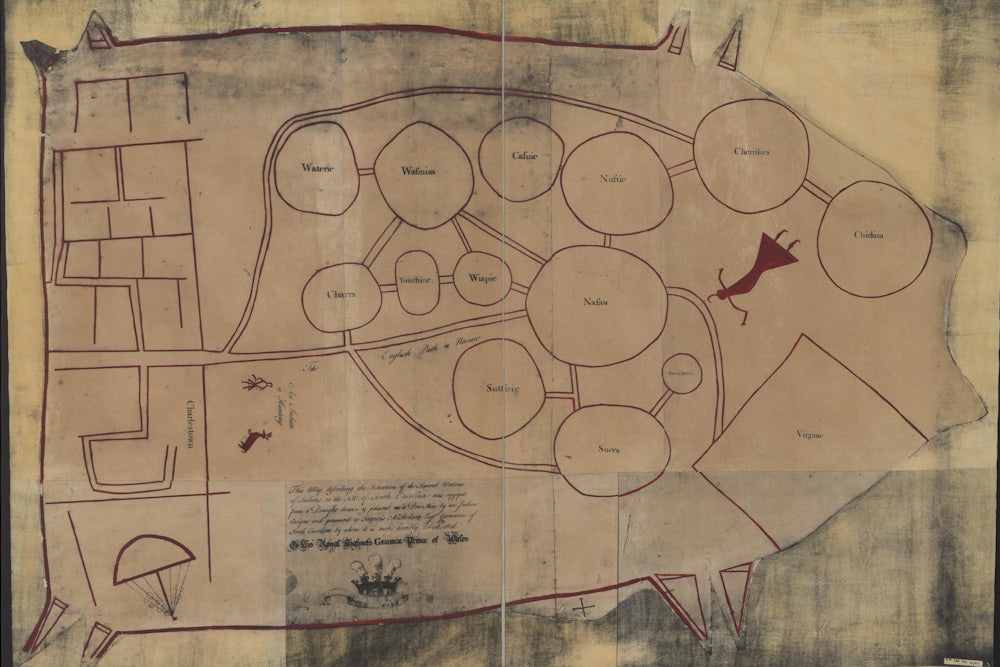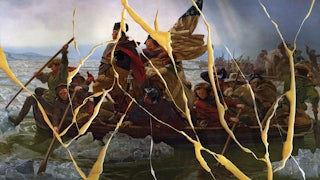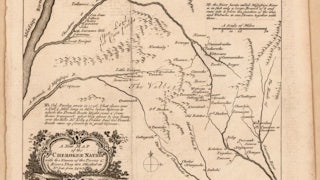Though it exists today only in photographs and fragments, Horatio Greenough’s 1853 statue group, The Rescue, still retains the power to shock. Looming over the East Front of the U.S. Capitol for more than a century, it depicted a grotesquely large white man in neoclassical garb subduing an equally caricatured Native American, while a cowering white woman snatches her child away in the background. Despite generations of scholarship on Indigenous America, many Americans still imagine the United States as a nation born distant from the wars of powers and principalities, unstained by the carnage of various “bloodlands.” Nineteenth-century Americans and their statues were more honest: For them, the U.S. was a new Rome, self-consciously imperial and violent, the aspiring victor in a brutal and, at that time, undecided 400-year war for control of North America.
It is this ferociously imperial United States that emerges from Pekka Hämäläinen’s valuable new book, Indigenous Continent: The Epic Contest for North America, and it does so precisely because the U.S. is not his focus. As his title indicates, Hämäläinen instead tells the story of an Indigenous North America, one that emerged tens of thousands of years before Columbus arrived, remained dominant until the nineteenth century, and endures to the present.

Beginning the story of North America with the ancestors of Native Americans crossing the “Beringia” land bridge from Asia into Alaska is, of course, nothing new. Surveys of North American and U.S. history have long abandoned the habit of opening with England’s first colonial outposts for more inclusive considerations of the pre-Columbian Indigenous world. However, in many works, this moment serves as a mere prelude for the “real” event: the arrival of Europeans. By the time the English alight on the Virginian strand, the action has shifted, the story is now a European story, with Native Americans as relatively powerless supporting actors and victims. History flows westward, out from the colonies on the Atlantic coast and into a nominally Native “frontier.” As Hämäläinen puts it, Europeans in such narratives seem “destined to take over,” and history itself becomes a “linear process that moves irreversibly towards Indigenous destruction.”
Indigenous Continent undertakes the monumental task of telling the story the other way around, of “facing East from Indian country,” as Daniel K. Richter suggested in his seminal 2001 book. The results are a starkly different narrative, in which the “maps of modern textbooks that paint much of early North America with neat, color-coded blocks” are revealed to be fictions that overstate Europeans’ actual holdings. More accurate maps might look somewhat like those in old textbooks depicting the Germanic invasions of Rome, with communities of European invaders rendered as arrows pushing up against stubbornly resistant Native American sovereignties. In this telling, the history of North America is firmly anchored around polities such as the Powhatan Empire, the Iroquois Confederacy, and the Lakota and Comanche Empires. These communities emerge not as bit players in a story of European expansion—stepping in and out of a fog hanging just beyond the frontier of settlement—but as part of a continent with its own political history.
Hämäläinen thus looks to reverse the geographical direction of North American history, beginning instead in the northwestern corner of the continent and moving south and east as early Indigenous Americans migrated down from Alaska and across the Rocky Mountains around 11,000 BCE. Spreading across the land over the subsequent millennia, they built a variety of different societies, some relatively egalitarian, others much more hierarchical. Among the most physically impressive of the latter were the various “Mound Builder” cultures that emerged between the Great Lakes to the lower Mississippi Valley in a period running from roughly 1700 BCE to 1400 CE. The Adena-Hopewell people who lived in today’s Ohio, for example, or the Cahokia in southern Illinois, were relatively centralized societies, erecting large earthen mounds as religious and economic centers, many of which can still be seen today.
Indeed, the Mound Builders offer a window into an alternative history for North America, one where hierarchical, theocratic states, akin to the Aztec or Incan civilizations of Central and South America, ruled the continent. Instead, North and South America diverged in the thirteenth and fourteenth centuries, as climate change, in the form of a period of global cooling known as the “Little Ice Age,” undermined the agricultural base of the Mound Builders. Colder temperatures and lower crop yields, Hämäläinen writes, “ushered in a world where almost everything had to be smaller … markets, settlements, mounds, alliances, and ambitions.” Rather than a continent of centralized, elite-dominated polities with significant divisions of labor, North America became a land of “generalists.” Smaller communities prevailed, where labor was divided by gender, to the degree that it was divided at all, and all were expected to participate in each of the various activities by which the group sustained itself. The village-dwelling, Algonquin-speaking communities—like the Powhatan and Wampanoag—that first encountered English settlers on the Eastern Seaboard practiced just such an economy.
Indigenous Continent’s history of precolonial North America is unavoidably cursory; traditional archival sources are almost nonexistent, and building any narrative requires a good bit of conjecture. Yet it provides an indispensable frame for understanding the war for the continent that followed. In the centuries when Europeans were building centralized, territorially bound states, Indigenous North Americans were moving in the opposite direction. They adopted a more egalitarian and decentralized politics, one tied more to relationships than territory. Real and fictive kinship was central to this form of state building. Powerful Native American leaders gained their authority by developing durable connections with other families and villages, making them their kin. This was sometimes done via violence and forced tribute, but gift giving and reciprocity were just as important. The more a leader could give away, the more influence he or she might have. A man like Wahunsenacawh, for example, the most important of the Powhatan when Jamestown was settled in 1607, was a conduit of power rather than a sole source of authority.
When they came under attack from Europeans, decentralized political forms made North American Indigenous communities resilient to conquest, Hämäläinen argues. With no emperor to depose or Tenochtitlan to capture, European invaders instead confronted what appeared to them a confusingly amorphous entity. Indigenous responses to the settlers were as varied as the communities in question but, on the whole, they frustrated and imperiled the European colonial project. All three main European players—Spanish, French, and English—first approached North America with raw conquest in mind but achieved only dubious results. Wahunsenacawh’s Powhatan Empire, for example, vigorously resisted English expansion in Virginia in three wars over the first half of the 1600s. Later that century a continent-wide Native American counterattack—spanning from the Pueblos of New Mexico to “King Phillip’s” or Metacom’s War in New England—forced the Spanish and French at least to reconsider their plans.
French settlers, unable to survive without some degree of Indigenous forbearance, built an alliance system based on mutual accommodation with groups like the Illini, Miami, Odawa, and Wyandot, among others. In return for nominal allegiance to the French crown, access to furs, and assistance in fighting the English, the French offered their allies weapons and support in conflicts with other Indigenous groups. By the early eighteenth century, “New France” was as much a Native American entity as not: Much of its population was Indigenous, and if there was any truth to its territorial claims, this was due to Native military power not French soldiers. While the French provided the ever-important firearms, they did not dictate terms to the alliance, and Indigenous wishes were often as important as missives from Versailles.
The English colonies, meanwhile, responded to their defeats by turning on themselves, hunting for witches in New England and collapsing into civil war during “Bacon’s Rebellion” in Virginia. What becomes clear from Hämäläinen’s narrative is that these colonial projects survived in large part because they served the purposes of certain Native groups at certain times: They provided access to firearms and the other highly valued manufactured goods from Western Europe like metal tools and colored glass. Some Native polities, like the Iroquois Confederacy, were able to skillfully play various colonial powers and other Indigenous societies against each other, making themselves important actors in the North American interior in the mid-eighteenth century, capable of dictating terms to the French or English. Neither European power wanted to risk driving the Confederacy—positioned between New France and the English colonies of New York and New England—and its soldiers into the arms of their enemies.
The Seven Years War, from 1756 to 1763, thus proved a turning point in the history of Indigenous North America—not only because it helped lay the groundwork for the American Revolution, but because it eliminated the French as players in the eastern part of the continent. This reduced first the Iroquois’ and, eventually, every Native community’s diplomatic room to maneuver. What had once been a multipolar political world increasingly took on a different cast, one where the suddenly dominant British Empire could not easily be rebuked.
The American Revolution retains its significance in Hämäläinen’s story too, but for different reasons than it does in conventional narratives of U.S. history. Viewed from west of the Appalachians, the end of British rule in the Thirteen Colonies was far from a triumphant moment for human freedom. It instead unleashed the United States, a new political entity much more responsive than London to the land-hungry and oft-genocidal demands of the European-American settler communities of the Eastern Seaboard.
Yet the Indigenous continent endured. Native American resistance mired the new United States in almost constant war during its first 20 years, “consuming nearly five-sixths of total federal expenditure year after year” during that period. Internal tensions over the degree to which U.S. policy should focus on accommodation with or elimination of Native Americans contributed to no small number of separatist schemes by settlers. They eventually got their man in the White House: Andrew Jackson, a vicious “Indian hater,” who instituted the brutal forced relocation of the Cherokee from the southeast.
In the mid-to-late nineteenth century, two Indigenous empires—the Lakota and Comanche—continued to resist American expansionism. Lakota military power provided a barrier against U.S. penetration into the Northern Great Plains: a “Lakota Shield,” as Hämäläinen calls it, protecting numerous other Indigenous communities. The Comanche did much the same, resisting intrusion in the Southwest for decades, exacting tribute from Native and European settlement alike.
In time, however, even this military power was worn down. In return for Native promises to disarm and peacefully remove from their ancestral lands, the U.S. government agreed to provide Native Americans with “reservations.” These were territories made up from smaller, more marginal lands, but they at least appeared to offer some prospect of self-determination. Defeated in battle or faced with the prospect of fighting a war against increasingly long odds, most surviving Indigenous communities accepted this fate by the end of the nineteenth century—only, in most cases, to be fundamentally defrauded by subsequent state and federal policy.
However, even the existence of reservations is a sign of Indigenous strength, Hämäläinen argues, not weakness—they stand as monuments of resilience. Exhausted from decades of warfare, the U.S. government was forced to pursue a form of accommodation many of its leaders had long resisted. “The colonists, after all,” Hämäläinen writes, “would have absorbed every inch of North America if not denied by the continent’s Indigenous inhabitants.”
For all Hämäläinen’s efforts, Indigenous Continent cannot completely transcend European-focused narratives. Telling the story of Indigenous America often requires reading European sources against the grain, tugging the narrative back toward Europe at times. The book also focuses almost exclusively on political and diplomatic maneuverings, to the expense in some degree of Indigenous cultural and economic history.
Still, Hämäläinen’s book powerfully shows how different history seems, a step removed from the European perspective. One needs to look no further than a 1721 Catawba map reproduced early in the volume to see how crude and strange the patterns of settler life appeared to those who saw them from the outside, Indigenous witnesses to the violent reordering of the world. More than three-quarters of the map depicts the social life of the Catawba, a series of interconnected circles representing their villages, kinship ties, and allegiances. In what represents the East on the map, however, the organic shapes change ominously into the angular lines and street grids of the English colonies—like some eighteenth-century version of Star Trek’s Borg, slowly consuming the ancient landscape.
Nineteenth-century European-Americans went to great lengths to present those straight lines as “progress,” the march of “civilization” across the North American wilderness—celebrating their own brutality by erecting Greenough’s statue alongside the Capitol steps. The Rescue was eventually removed during a renovation in 1958. Discordant with the “leader of the free world” image the U.S. was cultivating during the Cold War, it was never restored. The narrative it represented has proven harder to dismantle.






